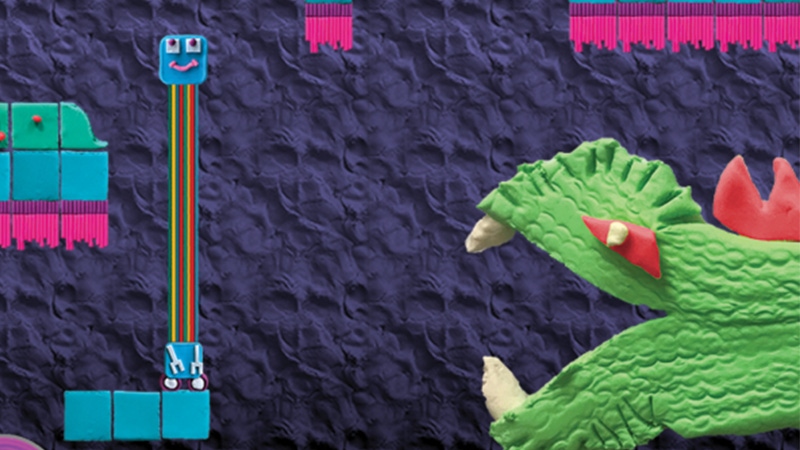Trending
Opinion: How will Project 2025 impact game developers?
The Heritage Foundation's manifesto for the possible next administration could do great harm to many, including large portions of the game development community.

Featured Blog | This community-written post highlights the best of what the game industry has to offer. Read more like it on the Game Developer Blogs or learn how to Submit Your Own Blog Post
Working with play-doh to create a unique look for an indie platformer.

Schmutznik is a 2D platform game that uses play-doh for a unique visual art style. In the game, you control a robot who cannot jump but, instead, can extend its neck to reach higher platforms. By choosing the platforming genre, I was able to play with all kinds of game mechanics, using the limitation of minimal controls - left, right, and an action button - and a lack of jumping to explore many gameplay ideas.
During its long development time, I considered and experimented with a range of different media for the game’s look. This probably is due to my nature as an illustrator where I frequently play with different art materials to come up with a good solution for each client’s need. Even though you control a robot in the game which, by its nature, is mechanical and precise, I wanted to contrast this with an art style that gave a more handcrafted feel to the game world.
Play-doh is an interesting medium to work with because, in my experience, I found it difficult to make it look perfect. However, this loose style suited the homemade quality of the world I was creating for players. While there is a basic story – use your robot to clean up underground caves, avoid mutated creatures, and find the exit – I felt a photorealistic style would not have worked for the game's narrative where giant grasshoppers spit tiny grasshoppers at you and lava angrily rises when you accidentally sacrifice a sleeping moth to it.
Throughout the creation of Schmutznik, I would regularly code and reject lots of ideas - I wanted each cave to introduce some new mechanic to keep gameplay fresh. It made no sense to model, photograph, edit, and clean up clay models for something that, after playtesting, might not be particularly fun to play. So, I made the quickest and messiest artwork for every new idea I had. If the new mechanic was engaging regardless of how bad it looked then better art would only improve the experience. And if the idea did not work then it did not hurt to delete the poor-quality preliminary images and code – no time making complex art was wasted, and the art assets did not feel too precious. I cannot stress how important this part of game development is. Artwork is not important when figuring out how to create engaging mechanics. When a gameplay element is successful, art can only elevate the player experience.

(Above, left) - Prototype version of a crusher, a timed gate that would punish the player if entered incorrectly. (Above, right) - Final play-doh version of the crusher.

(Above, left) - Blobs of digital paint to create an enemy. (Adobe, right) - Final play-doh version of a dragini.
The other thing I want to mention in this article is that sometimes you do not need extravagant art studios or materials to make the visuals for your game. To prototype ideas, I used the art editor in GameMaker Studio to throw together some art very quickly. When a gameplay idea proved it could work, I took my children’s play-doh tubs and start shaping whatever it was that needed to be made. Finished models were photographed with an iPhone 7. I borrowed an old iPhone camera tripod from my father-in-law, but it struggled to hold a position without slowly collapsing. Raiding my children’s room again I grabbed their box of Duplo Lego which allowed me to make a solid camera stand. For height, I stacked some of our children’s hard-backed books. Again, utilizing what I had on hand meant that my art ‘studio’ was scrappy but worked, and could be quickly broken down before the children returned from school. Photoshop’s Object Selection tool was excellent for background removal and the software also allowed me to test animations using the Timeline to ensure an enemy’s movement looked decent.

(Above) - Using whatever is on hand to photograph art.
Creating artwork with play-doh is certainly a slower way to make game art assets than working in a digital art application, but the upshot is that Schmutznik has an uncommon visual style. Regardless, prototyping ideas and art styles is utterly important so that you can work as efficiently and smartly as possible.
Schmutznik is available on the Steam store here - https://store.steampowered.com/app/1607500/Schmutznik/ - and on itch here - https://avram-dumitrescu.itch.io/schmutznik
Read more about:
Featured BlogsYou May Also Like